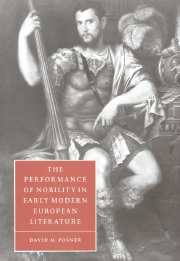Book contents
- Frontmatter
- Contents
- Acknowledgments
- 1 Introduction: “The Noble Hart”
- 2 Montaigne and the staging of the self
- 3 Mask and error in Francis Bacon
- 4 Noble Romans: Corneille and the theatre of aristocratic revolt
- 5 La Bruyère and the end of the theatre of nobility
- Notes
- Bibliography
- Index
- Cambridge Studies in Renaissance Literature and Culture
1 - Introduction: “The Noble Hart”
Published online by Cambridge University Press: 22 September 2009
- Frontmatter
- Contents
- Acknowledgments
- 1 Introduction: “The Noble Hart”
- 2 Montaigne and the staging of the self
- 3 Mask and error in Francis Bacon
- 4 Noble Romans: Corneille and the theatre of aristocratic revolt
- 5 La Bruyère and the end of the theatre of nobility
- Notes
- Bibliography
- Index
- Cambridge Studies in Renaissance Literature and Culture
Summary
Edmund Spenser summed up the aspirations of a class and an age when he described, in the Faerie Queene (I, v, 1, 1–4), the state of mind of the Redcrosse Knight on the eve of a great tournament:
The noble hart, that harbours vertuous thought,
And is with child of glorious great intent,
Can never rest, untill it forth have brought
Th' eternal brood of glorie excellent …
This image of nobility – as something pure, unmediated, even innocent – is one which late Renaissance nobility liked to hold of itself, at a time when the possibility of artless, unconstrained public self-presentation seemed as if it were rapidly being foreclosed. The historical position and identity of the nobility were being threatened by the rise of the modern nation-state and the new power and importance of the princely court. A nostalgic yearning for a Golden Age of artless self-presentation thus formed an important part of the ideology of nobility in this period. Spenser's text itself executes a double movement of optimism and despair; even as these lines enunciate the idealized image of the “noble hart,” they simultaneously suggest the impossibility of its realization.
- Type
- Chapter
- Information
- Publisher: Cambridge University PressPrint publication year: 1999



